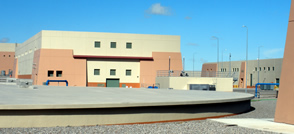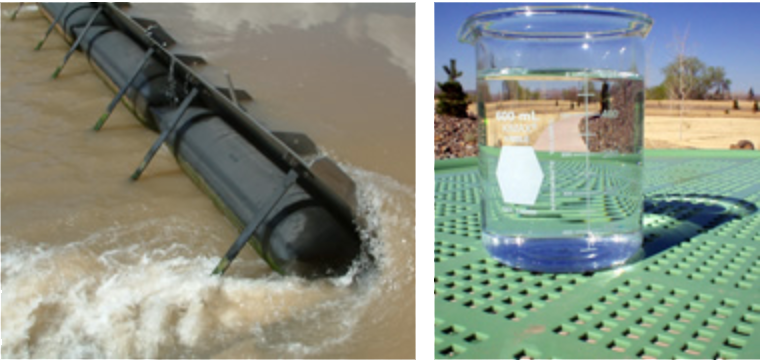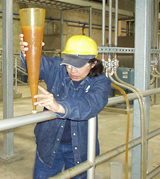Finished Water Monitoring at the San Juan-Chama Drinking Water Project Surface Water Treatment Plant

After treatment, finished water is stored in two 10 million gallon below ground storage tanks. (one pictured in foreground).
USEPA sets regulations that limit the amount of certain substances in drinking water. USEPA defines where and how often samples for each substance must be collected and how they must be analyzed. The table below shows only the substances found in compliance monitoring for the finished water at the Surface Water Treatment Plant. For surface water, USEPA also requires that specific treatment techniques are used and that the treatment techniques are effective. (Detection Limit in parentheses.)
2022 Results of Finished Water Compliance Monitoring at the San Juan-Chama Drinking Water Project Surface Water Treatment Plant
| Substance | Maximum Contaminant Level (MCL) | Maximum Contaminant Level Goal (MCLG) | Minimum Detected | Average Detected | Maximum Detected | Source |
| Microbiological | ||||||
| Cryptosporidium (untreated water)1 |
TT | Zero Oocysts/L | Zero Oocysts/L | 0.004 Oocysts/L | 0.093 Oocysts/L | Human and animal fecal waste. |
| Turbidity A measure of cloudiness of the water. It is a good indicator of the effectiveness of the filtration. |
1 Nephelometric Turbidity Unit (NTU) | Zero NTU | 0.03 NTU | Not Applicable | 0.13 NTU | Soil runoff |
| 95% of the finished water samples must be less than 0.3 NTU | Zero NTU | 100% of the samples taken in one month were less than 0.3 NTU. | ||||
| Total Organic Carbon (TOC) | TT | Not Applicable | Zero PPM | 0.9 PPM | 1.5 PPM | Naturally present in the environment. |
| Minerals | ||||||
| Fluoride | 4 PPM | 4 PPM | 0.51 PPM | 0.57 PPM | 0.72 PPM | Erosion of natural deposits. |
| Nutrients | ||||||
| Nitrate | 10 PPM | 10 PPM | Zero PPM | 0.46 PPM | 2.96 PPM | Erosion of natural deposits. |
| Disinfection By-Products | ||||||
| Bromate2 | 10 PPB | Zero PPB | Zero PPB | 1.7 PPB | 3.8 PPB | By-product of drinking water disinfection. |
| Substance | Maximum Residual Disinfectant Level (MRDL) | Maximum Residual Disinfectant Level Goal (MRDLG) | Minimum Detected | Average Detected | Maximum Detected | Source |
| Disinfectants | ||||||
| Chlorine | 4 PPM | 4 PPM | 0.6 PPM | 1.4 PPM | 1.5 PPM | Disinfectant (sodium hypochlorite) |
| PPM = Parts Per Million PPB = Parts Per Billion NTU = Nephelometric Turbidity Unit Treatment Technique (TT): A required process intended to reduce the level of a contaminant in drinking water. 1 Summary of results from samples collected over 24 months, between April 2015 and May 2017. 2 USEPA Health Effects Language: Some people who drink water containing bromate in excess of the MCL over many years may have an increased risk of getting cancer. |
||||||
The Purification Process

Safe Drinking Water Act standards are designed to provide maximum protection for the public’s health. Surface water is treated according to these health based standards at the San Juan-Chama Surface Water treatment plant. Here’s how:
- Water withdrawn from the Rio Grande is treated with a coagulant, ferric chloride, to remove particles. Polymer helps by making small particles clump together.
- Ozone gas to kills bacteria and viruses. Ozone also breaks down naturally occurring organic material.
- A multistage filtration system is used to remove any remaining microscopic particles from the water. Granular activated carbon (GAC) removes taste and odor compounds found in surface water.
- Chlorine is added to disinfect the water and protect the quality. Corrosion inhibitor protects pipes and home plumbing.
The Water Authority uses advanced computer technologies to move water through the distribution system and monitor water quality. The entire treatment process is designed to provide drinking water that meets or exceeds all state and federal Safe Drinking Water Act standards for water quality.
Source Water Monitoring for the San Juan-Chama Drinking Water Project Just How Safe Is It?
For many years, the Water Authority has monitored the Rio Grande to establish a water quality baseline. Samples are collected at various sites along the river from the Heron Lake outlet to Albuquerque’s diversion dam site. Heron Lake stores San Juan-Chama water. Visit USGS website for monitoring results.

It takes about three hours for water to travel from the diversion dam (pictured on left) to the settled water ponds at the surface water treatment plant. After settling for at least a day in the ponds, it only takes two or three hours of treatment to produce the clean, finished drinking water pictured on the right.
The monitoring results compare favorably to USEPA drinking water quality standards. Because no metals, minerals, or nutrients nor organic substances have been detected in excess of USEPA standards, river water will meet requirements for those substances. Likewise, levels of radionuclides detected in the river water are far below USEPA standards and the risk of radioactivity potentially flowing from Los Alamos is extremely low.
Water treatment will remove particulate matter from the water including turbidity, sediment and microbial contaminants such as bacteria, Giardia and Cryptosporidium. The Water Authority monitored for Cryptosporidium in the San Juan-Chama surface water (source water) from June 2008 to May 2010. Cryptosporidium was detected at low levels in only four out of the 24 monthly samples collected. No additional treatment is required because of the low occurrence of Cryptosporidium in the San Juan-Chama surface water. A second round of monitoring for Cryptosporidium began in 2015 and continued through the spring of 2017. A single Cryptosporidium oocyst was detected in one of the monthly samples collected during 2016.

Surface water treatment plant operator checks the settling rate.
Ozone and granular activated carbon filtration are effective in removing organics, including pharmaceutically active compounds that may have found their way into the river. If such compounds show up, they will be oxidized, then absorbed onto the filters.
Additional samples will be collected every year to determine water quality changes over time. This information will assist the Water Authority in modifying or refining treatment or identifying the need for additional treatment to ensure the high quality of our drinking water.
Download Results for Voluntary Monitoring
From 2007-2008, the Water Authority operated a Pilot Plant. Results of source and finished water monitoring from that effort are provided below:
2007 Pilot Plant: Source Water Quality Voluntary Monitoring Results
2007 Pilot Plant: Finished Water Quality Voluntary Monitoring Results
2008 Pilot Plant: Source Water Quality Voluntary Monitoring Results
2008 Pilot Plant: Finished Water Quality Voluntary Monitoring Results
Additional Monitoring
Since the San Juan-Chama Drinking Water Project came online, the Water Authority has conducted additional monitoring. Results from late 2008 through 2011 are summarized below:
San Juan Chama Drinking Water Project Source Water Quality Voluntary Monitoring Results 2008-2011
San Juan Chama Drinking Water Project Finished Water Quality Voluntary Monitoring Results 2008-2011
Pharmaceuticals & Personal Care Product Occurrence Monitoring Report
Pharmaceuticals & Personal Care Product Occurrence Monitoring Report Update – March 2012
Contaminants of Emerging Concern Voluntary Monitoring Report November 2021

